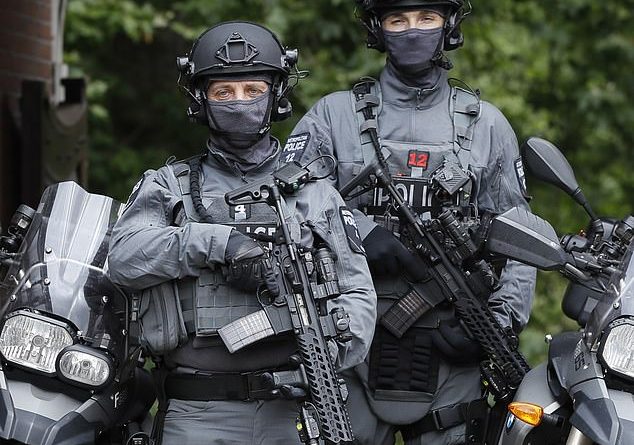Gun test shows new body armour may NOT save the lives of Britain’s police
[ad_1]
The lives of Britain’s elite soldiers and police officers could be at risk from inadequate new body armour, a safety test carried out for The Mail on Sunday has revealed.
Safety experts said the result of our experiment on the lightweight polyethylene chest plates, increasingly being rolled out among Special Forces, Royal protection teams and anti-terrorism units was ‘alarming’.
And one serving SAS soldier said: ‘I’d sooner go into battle wearing no ballistic protection than using this plate. It shouldn’t have been brought into service.’

At risk? Police counter-terrorism officers (pictured in London in 2016) are increasingly using the lightweight polyethylene chest plates
The Ministry of Defence and the Home Office have declared the armour safe, but there are fears the tests they used to come to that conclusion are inadequate.
‘The testing process isn’t fit for purpose so lives are being put at risk,’ said defence manufacturer Andrew Kerr, who added that he had raised his concerns officially, but they had been ignored.
The risk comes from what’s called ‘behind armour blunt trauma’, caused as the plate bulges into the body when it absorbs the force of a bullet, and which could cause major injury or even death.
In one of the tests we commissioned at a Government-approved laboratory, a polyethylene chest plate was put in front of part of a pig’s torso, traditionally used in such tests as it has similar properties to a human body, and shot.
The impact caused severe damage, ripping into the heart. After examining photographs, a senior NHS trauma consultant said: ‘These are unsurvivable injuries. The heart has been macerated by the blunt force trauma projected through the plate. This evidence gives genuine cause for concern.
‘There is an urgent need for further study. An enormous amount of force is pushed through the plate even though the plate stops the round. While a human heart has more protection than a pig’s heart, due to the positioning of the chest wall, this is still alarming.’

Impact: Clay damaged when protected from 7.62mm bullets, above, by the armour. The Ministry of Defence and the Home Office have declared the armour safe
Yet in the same series of tests, conducted using official standards on variables such as the speed of the bullet, the armour passed MoD and Home Office safety limits.
Neither body makes public which body armour plates they use, citing security reasons, so our experts chose a make commonly worn around the world.
The first test replicated the process used by the Government when a plate is mounted in front of a clay mould and a 7.62mm round fired into it from a set distance. The depth of the indentation the impact made in the clay through the armour was 24mm – less than the 25mm maximum required by the Home Office and the 44mm MoD limit, also used by other countries.
But that same impact force was enough to cause such major damage to the pig. In comparison, tests on the heavier ceramic plates, which the plastic ones are replacing, showed there was no damage to either the clay or the pig, which had been humanely killed at an abattoir and was otherwise destined to be sold as food. Mr Kerr, a former member of the Home Office safety standards committee, said: ‘The standards of 25mm and 44mm are entirely arbitrary, bearing no relation to injuries caused by this trauma.
‘Considering the popularity of lightweight ballistic plates in elite military units and police detachments, more sophisticated tests need to be introduced quickly.’

The chest plates pictured being tested on pig meat, which is traditionally used in such tests as it has similar properties to a human body, and shot
Lee Trueman, a former police firearms officer and ballistics expert, also said the current tests were inadequate: ‘There would appear to be no direct relationship between the 25mm and 44mm standards to any human injuries.’
Che Donald, of the Police Federation, and Mark Williams, head of the Police Firearms Officers Association, last night issued a joint statement saying: ‘Anything that suggests equipment may not be fit for purpose needs to be further investigated as a matter of urgency before any serious injury or loss of life.’
Calling for an investigation, former Shadow Defence Minister John Spellar said: ‘The Mail on Sunday’s findings clearly show the need for a rapid review and update of safety standards to save lives.’
A Government spokesman said: ‘We take the safety of our police officers and Armed Forces extremely seriously.
‘The MoD and Home Office procure various types of body armour, all of which are rigorously assessed using internationally recognised test standards with the relevant roles and threat level in mind. We have not seen any evidence to indicate that the current standards do not provide adequate protection.’
[ad_2]
Source link


